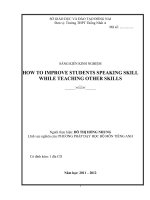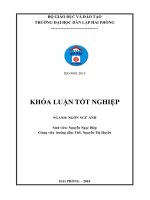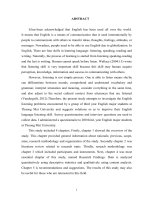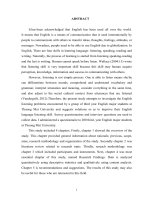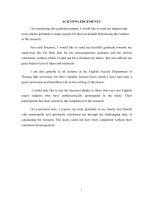skkn HOW TO IMPROVE STUDENTS SPEAKING SKILL WHILE TEACHING OTHER SKILLS
Bạn đang xem bản rút gọn của tài liệu. Xem và tải ngay bản đầy đủ của tài liệu tại đây (290.88 KB, 18 trang )
SỞ GIÁO DỤC VÀ ĐÀO TẠO ĐỒNG NAI
Đơn vị: Trường THPT Thống Nhất A
Mã số: ................
SÁNG KIẾN KINH NGHIỆM
HOW TO IMPROVE STUDENTS SPEAKING SKILL
WHILE TEACHING OTHER SKILLS
____________
Người thực hiện: ĐỖ THỊ HỒNG NHUNG
Lĩnh vực nghiên cứu: PHƯƠNG PHÁP DẠY HỌC BỘ MÔN TIẾNG ANH
Có đính kèm: 1 đĩa CD
Năm học: 2011 – 2012
1
SƠ LƯỢC LÝ LỊCH KHOA HỌC
I. THÔNG TIN CHUNG VỀ CÁ NHÂN
1. Họ và tên: ĐỖ THỊ HỒNG NHUNG
2. Ngày tháng năm sinh: 7/5/1978
3. Nam, nữ: Nữ
4. Địa chỉ: Khu phố 5- TT Trảng Bom - Trảng Bom - Đồng Nai
5. Điện thoại: 061 3864198 (CQ) – 061 3921574 (NR)
ĐTDĐ: 0917466656
6.
Chức vụ: Phó hiệu trưởng
7.
Đơn vị công tác: Trường THPT Thống Nhất A
II. TRÌNH ĐỘ ĐÀO TẠO
1. Trình độ chuyên môn: cử nhân ngoại ngữ
2. Năm nhận bằng: 2000
3. Chuyên ngành đào tạo: Anh văn
III. KINH NGHIỆM KHOA HỌC
1. Lĩnh vực chuyên môn có kinh nghiệm: Giảng dạy
2. Số năm có kinh nghiệm: 12 năm
TOPIC: HOW TO IMPROVE STUDENTS’ SPEAKING SKILL
WHILE TEACHING OTHER SKILLS
CONTENT
I. INTRODUCTION
II. THE TEACHING AND LEARNING ENVIRONMENT
1. Advantages
2. Disadvantages
3. Statistics
III. SOLUTIONS
1. While teaching speaking itself
2. While teaching other skills
3. While teaching language focus
IV. CONCLUSION
Topic :
HOW TO IMPROVE STUDENTS’ SPEAKING SKILL
WHILE TEACHING OTHER SKILLS
I. THE REASON WHY THE TOPIC IS CHOSEN
Speaking is a crucial part of language learning. The mastery of speaking skill in
English is a priority for many second or foreign language learners. Nowadays, many
learners even consider the ability to speak the language is the aim of language
learning. They often evaluate their success in language learning as well as the
effectiveness of their English courses on the basic of how well they feel they have
improved in the spoken language proficiency. Despite its importance, for a long time,
teaching speaking has been under valuated. Traditional teaching methods have
seemed to emphasize the learning of language system (rules of grammar and , lists of
vocabulary items ..) as a goal in its own right and failed to give learners an ability to
gain realistic experiences in actually using the language knowledge gained.
Moreover, very often when people study a language, they accumulate a lot of 'up-in
the head ' knowledge, but then find that they can't actually use this language to
express what they want to .There seems to be some difficulties in moving language
from 'up-there ' knowledge to actively usable language . Without experience in using
the language , students may tend to be nervous about trying to say things. Nowadays
things have been different. Today's world requires that the goal of learning speaking
English should develop students' communication skill so that students can express
themselves and use the target language to state opinions, express their feelings and
exchange information. Many new teaching methods have been introduced and applied
to serve the basic need of English learners. Among them ,communicative approach
and learner-centered approach seem to be the most effective ways to teach oral
communication. And we should apply these methods in teaching the four skills and
focus on designing speaking activities in appropriate stages of English lessons while
teaching other skills so that students always have a lot of chances to practise speaking
while learning English.
In Viet Nam, there has been also a reform in teaching English in secondary
schools as well as High schools. The new series of textbooks presently used in
secondary schools and high schools were designed in view of communicative
language teaching method. The topics of the lessons given in the textbooks are really
interesting and based on real- life situations that require communication.
In spite of many efforts of teachers and others , the results we get from our
students are unsatisfactory. Students still complain that they find speaking lessons
really stressful and thus speaking is a difficult skill to master. Many students , after
studying English for years ,have left school without being able to speak an
intelligible sentence . Therefore, in this writing I would like to tell you how to
improve the students’ speaking skills while teaching English so that we can help
students to improve their speaking skills. But first of all, I would like to introduce
something about the teaching and learning environment of the place where I teach.
II. THE TEACHING AND LEARNING ENVIRONMENT:
1. Advantages :
Like some other regimes , there are some advantages and disadvantages for the
teaching and learning of the language in my school.
First, the students are very eager to learn the language . They say that they want
to learn English to listen to music, to read books, and especially to communicate
with foreigners. This is to say that they have instrinsic motivation towards the
learning and practising speaking English.
Second , it is the objective factors that influence the students' learning
motivation. The fact that our country has opened trade relations with all countries
in the world and implemented the policy of encouraging domestic and private
investment and the joining WTO of our country have been an impetus for the
students to learn to communicate in English for their jobs in the future . In other
words, this factor has motivated the students greatly
Third, as I have said above, the new series of textbooks were designed to serve
communication need of students as well as in view of communicative language
teaching method. So students really have a lot of chances to practice in real
situations
Finally, high school students have been provided with necessary language
knowledge such as vocabularies, grammatical rules as well as language
competences so that they can have the ability to communicate in English in certain
situations
2. Disadvantages
Besides the advantages discussed above ,there are plenty of difficulties that
affect the learning and teaching of the language in my school
To begin with, there are too many students in a class. Nomally, each class
contains more than 40 students. In addition, all of the classes are fixed with rows
of desks. This makes it difficult for teachers to organize communicative tasks and
keep control of the class
Second, most of the students are not good at the language , especially their
communicative competences are poor although they have been exposed to the new
curriculum since they were in secondary school. Normally most of them don’t know
how to talk about the topic given. They can’t make up the ideas to express in
English because their vocabularies, structures are still limited. Furthermore, they
often look for a specific word rather than using simple language to describe what is
meant, so it takes them a lot of time to be able to speak up a whole sentence.
Many students find it very difficult to show their ideas in English due to
nervousness and lack of confidence in front of the class. They feel shy, they are
afraid of being laughed at, being lost face with their friends when they have
mistakes. As a result, the class is tense and passive because students don’t want to
say out their thought.
Then although English is one of the core subjects , which are compulsory in
final examinations at certain stages of the school education system, speaking skill is
not usually included in their exams so sometimes students just learn English for
written exams not for communication as the aim given.
Grade
Number of
students
135
Mark 5 and over
total
rate
50
37%
Under mark 5
total
rate
85
63%
11
3. Statistics
According to the survey carried out at the beginning of this school year, more than
70 % of the students reported that they are worried about their English . They said
that they could hardly make a simple conversation in English or express what they
thought . Importantly, most of them assumed that like writing, speaking is also
difficult for them to master.
III. SOLUTIONS
A.Improving students’ speaking skill while teaching speaking itself.
There are many rules we must remember while teaching speaking so that we can
help students improve their speaking skill:
1. Firstly, we must make sure that students feel safe and confident while they
express themselves
Personally I think that , the first thing that teachers have to do to help students
improve their speaking skill is that they have to help them overcome their feelings
of shyness and nervousness when practising English in their class .One of the best
ways to solve this problem is to put them in 'safe' situations in class where they are
inspired and encouraged to try using the language from their 'store'. Organizing
communicative activities in pairs , in groups is also an effective way to serve this
aim. Working in pairs , in groups , students will feel less anxious than when they
are 'on show' in front of the whole class together. Moreover, pair-works and group-
works can help shy students who would never say anything in a whole class activity
have the confidence to open their mouths. Students can also learn from each other's
new ideas so that they will have something to speak in front of the class later.
Another thing that teacher should remember to help students have confidence in
speaking is teacher's positive corrections and feedbacks . Making errors is a natural
and unavoidable part of the learning process, but how to correct the students’ errors
is particularly important. You need to provide appropriate feedbacks and
corrections, but don't interrupt the flow of communication. Take notes while pairs
or groups are talking and address problems to the class after the activity without
embarrassing the student who made the error. We can also write the errors on the
board and ask who can correct it.Teachers should encourage their students to speak
whatever they can and focus on what they have got right, not on what they have got
wrong. We should also help them to develop positive attitudes towards their
friends’ errors and to correct themselves. Teachers should try to develop for
themselves positive strategies of error corrections. When students achieve success
in oral communication, they will feel confident, secure and enjoy learning English;
they will have confidence to take part in communicative activities later.
2. Secondly, we must pay attention to warm-up activities:
Warm-up is also an important part which contributes to the success of a
speaking lesson. Warm-ups help our learners put aside their daily distractions and
focus on English. If they haven't used English all day, they may take a little while
to shift into it. Warm-ups also encourage whole-group participation which can
build a sense of community within the group and they can help to arouse student'
interest in speaking. We should vary warm-up activities to attract our students'
attention and interest because if they feel good about the lesson from the
beginning they'll make a good contribution to it These may be a discussion, a
picture describing activities or playing a game, brainstorming...ect In order to have
a good preparation, the teacher does different things to arouse students’ interest,
i.e brainstorming, musical warmer, word card, etc. Before a new lesson I often
motivate the students by chatting to them about the topic of interest, giving them
preparation tasks or quick warm-up to get them in the right mood for
speaking.Brainstorming is one of the simplest, but the most effective kind of
motivation because it takes a short time. I can write key words on the blackboard
and the class is encouraged to think of ideas, words, phrases associated with them.
Example 1: Speaking in unit 12-English 10
When I teach speaking in unit 12-English 10, I may present a picture of a famous
singer or musician and asks them the following questions
1. Who is she?
2. Do you like her?
3. If not, who is your favourite singer?
4. What kind of music does she sing?
5. Teacher leads in new lesson
Example 2: Speaking/Unit 15/English 12
Teacher may raise some questions and ask students to discuss in pairs:
1. Do you think that women are as intelligent as men?
2. Do they have equal rights in the family and in the society?
Students ask and answer in pairs, then some students present their answer, teacher
leads in new lesson
Example 3 : Speaking-unit 6-English 12
T asks students to play a guessing game:" Find someone who.........."
Teacher divides the class into 2 groups
Teacher gives some information about some popular and interesting jobs in the
society and asks student to guess what job it is. Each time they can guess they got one
point
3.Thirdly, students must be well-prepared and instructed before they practice
speaking.
Another point that makes it difficult for students to practise speaking is that
their knowledge of the language is poor and they don't have ideas to talk about the
topic ;(their language competences, vocabulary and grammar are limited)so in order
to help students practice ,teachers have to provide them with necessary language
input and give students clear instructions
Example 1 : Task 2/speaking/unit 7/English 12
Teachers have to present some verbs used with the callocations given in the task by
asking students to do the matching
A
B
1. build
Teacher's salary
2. provide
Curriculum and textbook
3. reform
More school
4. apply
Teaching and learning method
5. train
More highly qualify doctors
6. raise
More equipment and facilities
Teachers also have to elicit the meaning of some words or phrase in the task
Example 2: Speaking/unit11/English 10
Before students practise, teachers have to present the form and use of conditional
sentences type 3 which is used to express a regret about what you did in the past
Example 3: Speaking /unit3/English 12
Teacher presents some ways of giving and responding to compliments
Giving compliments
Responding to compliments
You really have a beautiful blouse, Thank you , Phil. That's a nice compliment.
Babara
What a beautiful blouse it is !
You've got to be kidding! I thought it was
terrible
How beautiful you are!
Thanks, Peter. It's nice of you to say so
Congratulation. You've played so well Thank you. Your compliment is really
today
encouraging
Your hairstyle is terrific
4. Forthly, Varying communicative activities is also important
As I have just presented above, effective methods of teaching indirectly encourage
oral interaction and they can provide motivation. The direct way to promote oral
communication is to provide students with opportunities to participate and to
communicate with each other so that students can learn the language from speaking.
The more opportunities of speaking the language they have, the more fluent they
become. Actually, various activities in each lesson adds interest to students and can
help with making students more dynamic and active. In speaking ,students will be
motivated if teachers provide them with various communicative activities. Below are
some common speaking activities that I often carry out in my classes to make my
speaking lessons more interesting and to motivate my students in practising English:
a)
Discussions :In an discussion students may aim to arrive at a conclusion, share
ideas about an event, or find solutions in their discussion groups. Before the discussion
, it is essential that the purpose of the discussion activity is set by the teacher. In this
way, the discussion points are relevant to this purpose. In an discussion teacher can
form groups of 4 or 5 students . then each group works on their topic for a given time
period, and presents their opinions to the class. For efficient group discussions, it is
always better not to form large group because quiet students may avoid contributing in
large groups. Generally speaking , in class or group discussions, whatever the aim is ,
the students should always be encouraged to ask questions , paraphrase ideas, express
support, check for clarification, and so on
b)
Role play: One other way of getting students to speak is role-playing. Students
pretend they are in various social contexts and have a variety of social roles. In role play activities, the teacher gives information to the learners such as who they are and
what they think or feel.
c)
Information gaps: in this activity students are supposed to be working in
pairs. One student will have the information that the other partner does not have and
the partner will share their information. Information gap activities serve many
purposes such as solving a problem or collecting information. These activities are
effective because everybody has the opportunity to talk extensively in the target
language .the aim of this activity is to get learners to use the language they are
learning to interact in realistic and meaningful ways, usually involving exchanges of
information and opinions.
d)
Brainstorming: This helps students produce ideas in a limited time. The good
characteristics of brainstorming is that the students are not criticised for their ideas so
students will be open to sharing new ideas. Brainstorming is one of the simplest, but
the most effective kind of motivation because it takes a short time. Teacher can write
key words on the blackboard and the class is encouraged to think of ideas, words,
phrases associated with them.
e)
Storytelling:| students can briefly summarises a tale or story they heard from
somebody beforehand, or they may create their own stories to tell their classmates.
Storytelling fosters creative thinking
f)
Interviews: Students can conduct interviews on selected topics with various
people. It is a good idea that the teacher provides a rubric to students so that they
know what type of questions they can ask or what path to follow, but students should
prepare their own interview questions.
g)
Reporting Before coming to class, students are asked to read a newspaper or
magazine and, in class, they report to their friends what they find as the most
interesting news. Students can also talk about whether they have experienced
anything worth telling their friends in their daily lives before class.
h)
Group planning tasks: An example of this is planning a party or an excursion
for the whole group. In this activity , teachers should allow them a good amount of
time to prepare for a presentation in which they attempt to persuade the rest of the
class to agree with their arrangements
.
i)
Picture Narrating: This activity is based on several sequential pictures.
Students are asked to tell the story taking place in the sequential pictures by paying
attention to the criteria provided by the teacher as a rubric. Rubrics can include the
vocabulary or structures they need to use while narrating.
j)
Picture Describing : One way to make use of pictures in a speaking activity is
to give students just one picture and having them describe what it is in the picture.
For this activity students can form groups and each group is given a different picture.
Students discuss the picture with their groups, then a spokesperson for each group
describes the picture to the whole class. This activity fosters the creativity and
imagination of the learners as well as their public speaking skills.
5. Last but not least, we should also pay attention to these points:
The communicative activities listed above can help teachers a lot in promoting their
students' speaking skills because they are quite interesting and they give students a
reason to speak in different situations and about different topics. However, how
should teachers run an activity effectively so that they can achieve their aims is also a
problem. Here I would like to provide you with a basic route-map plan for running a
simple EFL activity(English as a Foreign Language)
Activity route map
1. Before the lesson: familiarise yourself with the material and the activity; prepare
any materials or texts you need
2. In class: Lead-in, preparation for the activity( this may be helped to raise
motivation or interests, or perhaps to focus on language items that might be useful in
the activity. model the conversation or the talk. Typical lead-ins are: show a picture
connected to the topic. Ask questions/write up or read out a sentence starting a
viewpoint. elicit reactions/ask students if they have ever seen/been/or done ect/make
a strong , controversial statement/ .... )
3. Set up the activity : give instructions, make groupings, organize the class ..ect
4. Run the activity: students do the activity, maybe in pairs or in groups while
teachers monitor and help
5. Close the activity and invite feedbacks from learners
6. Post activity: do any appropriate follow-on work
Example: Task 2-speaking-English 10/page 67
This task is a discussion activity.
Before the lesson ( teacher prepare at home )
In class : To lead in and prepare students for the activity, I may show them the
model of the boat and ask them about the different characteristics of each
section/present some useful expressions
for expressing agreements and
disagreements /teacher asks some good students to make an example in front of the
class before each group practise
Set up the activity : I would like you to work in groups of 3 or 4 students ,
deciding the best seat for each person mentioned in task 1.You have 7 minutes to
complete the task
Run the activity : Teacher lets students to carry out the discussion in groups,
move around and monitor the class
Close the activity : Teacher asks some groups to perform in front of the class
and gives feedbacks
Post-activity : Teacher asks students to present their choice ( which seat is the
most suitable for them )
Good atmosphere in the class and friendly relationship between teachers and
students. Presenting our opinions and feelings in front of a lot of people in our native
language has been a challenge to many people and using another language to
convey what we want to say is of course more challenging. Therefore if the teacher
does not encourage his students and make them feel good about their teacher and
their lessons ,the class will become tense and dull . Interaction can't take place in the
class effectively. As a teacher in a language class, we should always create a good
class atmosphere from the beginning because our students, especially young
students, will have no communication if they don’t feel good about their teachers
and their English class.
Teacher's and students' involvement :
The main aim of organizing a communicative activity is to get students to speak ,
then one way to achieve that would be for you to reduce your own contributions.
Probably the less you speak, the more space it will allow the students .It could be
useful to aim to say nothing while the activity is underway, and save any
contribution for before and after.
B. Improving students’ activities while teaching other skills.
1.Teaching reading, listening and writing.
As we have mentioned above, speaking is the most important skill to
any learners of English or any other languages. Therefore, we must help
students to make full use of every chance to practice speaking. This can be
done at different stages of the lessons : Pre-, while- and post- . Before students
read or listen to a text or write about a certain topic, they should be prepared
about what they are going to read in advance by discussing some questions and
talking about their own experiences relating to the topic. These activities can be
carried out in pairs or in groups, or sometimes the teacher asks questions and
the students answer. The teacher at this time should play the role of an assistant
.We use different ways to encourage our students to be engage in oral
communication and present their ideas. We can also apply this when we
present new language (vocabulary, structures, etc..) or review what they have
learned. We can make our students think and pay more attention to our
teaching by asking them for their opinions, suggestions, or encouraging them
to guess new words, having them contribute what they remember or already
know instead of introducing directly the new lesson. Some of the
communicative tasks we can give our students while teaching listening or
reading or writing are:
Discussions about the text
Summarising texts
Reviewing texts
Using a 'follow-up' speaking task related to the topic
Clearly, I can encourage those students to share the knowledge with those
members who do not and I can help my students make full use of every chance to
Practice speaking. And in fact, telling someone about what we have read, listen is a very natural
reaction to a text.
Speaking activities can be also used as a mean for students to check the answers
with each other after they listen or read the text. Students may answer the teacher’s
questions directly or discuss the questions in pairs.
In this stage, we can encourage students to talk by asking them to summarize
what they have read or listen. Students take turns to talk in groups and then they may
present the ideas in pairs. Telling someone about what we have read is a very natural
reaction to a text.
2.
Some illustrations of using communicative tasks while teaching
reading, listening or writing :
a. Pre-reading activity : while teaching reading Unit 1- English 11: Friendship:
Teachers give some ‘English proverbs’ about friendship and asks students to
work in groups to explain the meaning of each statement orally. After the students
have practiced, the teacher will asks them to exlain orally in front of the class. Then
the teacher will asks them the next questin: What are the quality of a good friendship?
A friend in need is a friend indeed.
Hold a true friend with both your hands
Be a person that your friend can trust.
A friend indeed is a person who always walks in while the rest of the world
walk out.
b. Pre-listening stages: Unit 2- English 11. (Listening)
Teacher asks students to work in groups. Each group will makes three sentences
to describe the picture. The teacher feedbacks and introduce new lesson.
c. Pre-reading, Unit 8- English 11. Teacher asks students to describe the picture
orally and then tell the whole class which occasion it is?
d. Post-reading, Unit 8- English 11. Teachers asks students to talk about their last
Tet holiday.
e. Pre-writing – Unit 8. T aks students to talk about different festivals before
writng….ect
C. While teaching language focus.
Teaching grammar sometimes makes students feel passive and bored. Mostly,
teachers only teach grammar rules and ask students to do excercises in a passive way.
If we observe Traditional Grammar Teaching class in most of the schools, we may
find out that nearly every teacher follows a simple way like this: firstly, the teacher
lists the grammar rules. Then, the students learn by heart all the rules and do some
exercises. Lastly, the teacher gives more written exercises such as blank-filling or
translation. This is quite similar with what we called 3p theory: presentation, practice
and production. These three stages convey different purposes. Presentation is to
present new language in context so that the meaning is clear, to present the new form
in a natural spoken or written text so that students can see its use in discourse, to link
the new form to what students already know, to check comprehension, to elicit the
form from students where possible and exploit their existing knowledge.
And when students learn English this way, some of them would have good
command of English especially in the examinations, but when they open their mouth,
they always find that they can’t get a proper word to express themselves or sometimes
when the author points out some mistakes in their speech they can hardly believe they
had made such silly mistakes. Most of the students mention that they are quite sure to
have learned the corresponding term but couldn’t help making mistakes when they
get to talking. That is the question which is going to be focused on today.Nowadays
most of us realize that to teach grammar lessons effectively so that students can not
only remember grammar rules but alsoapply the language in communication we
should resourcefully move as quickly as possible from certain pattern drills to oral
interaction because each student really likes talking about his or her own ideas and
feelings. We should give them a reason to use the structure we teach in conversation.
Let’s look at some examples :
a. Target structure: The simple past tense
Practice stage : To help students practice The simple past tense, the teacher may
ask his students to look at the picture of a famous film star 10 years ago and talk
about her:
+ At that time she was poor. She was not famous. She lived in a small village in
the South. She worked as a street vendor then. The teacher asks students to
practice in groups, taking turns to talk about themselves 10 years ago .
b. Practice stage: Simple present tense
T asks students to tell the whole class about their daily activities or tell
fairy tales using simple presents to make the story more vivid. It’s always
very interesting to talk about themselves. And the students will be bare in their
my that simple present is used to express a habit, a routine and in story-telling.
c. Target structure: Relative clauses
Practice stages ; Teachers devides the class into two group and asks them
to play a guessing games : Find someone who………….Each group will gives
a statement and the other group must guess who he or she is.
Ex: - He’s a person who works on spaceship.
- She is a person who works in a hospital.
- He’s a person who is caught because of shop-lifting or selling drugs..
d. Target structure: if clauses
Teachers give some cues and asks students to work in pairs asking and
answering questions using the cues given:
Cues ; See a pickpocket /get lost in a jungle/ have a lot of money/ Go to
Africa/President of a country.
Ex: A : What would you do if you are the President of our country.
B : I would issue many policy which is good for the poor.
A : What about you ?
B : I would try to make our country richer and richer.
Above are some examples in which we can use communicative tasks to help
students practice English while learning Grammar. Giving them as many chances
to practice speaking English as possible is the best way to help them improve
their speaking skill.
IV. CONCLUSION
* Results :
After some years of conducting these solutions , to my expectation, I have
gained satisfying results .I've found that my students have become more confident
and active in speaking lessons. Many of them said that they no longer feel their
speaking lessons stressful and burdened. Most of them admitted
speaking skill has been improved a lot day by day.
that their
This is the statistics this year
Speaking is an important part of second language learning to any learners. The
ability to communicate in a second language clearly and efficiently contributes to the
success of the learner in school and success later in life. Therefore, it is essential that
Grade
Number of Mark 5 and over
Under mark 5
students
total
rate
total
rate
11
135
90
66.7%
55
33.3%
language teachers pay great attention to help students develop their speaking skill
rather than leading students to pure memorization. Teacher should provide students
with a rich environment where meaningful communication takes place while teaching
any skill. .
The end
SỞ GD&ĐT ĐỒNG NAI
Đơn vị :Trường THPT Thống Nhất
A
CỘNG HOÀ XÃ HỘI CHỦ NGHĨA VIỆT NAM
Độc lập - Tự do - Hạnh phúc
Trảng Bom., ngày 29 tháng 5 năm 2012
PHIẾU NHẬN XÉT, ĐÁNH GIÁ SÁNG KIẾN KINH NGHIỆM
Năm học: 2011-2012
–––––––––––––––––
Tên sáng kiến kinh nghiệm: How to improve students’ speaking skills while teaching
other skills.
Họ và tên tác giả: ĐỖ THỊ HỒNG NHUNG
Chức vụ: Phó hiệu trưởng
Đơn vị: Trường THPT Thống Nhất A
Lĩnh vực: (Đánh dấu X vào các ô tương ứng, ghi rõ tên bộ môn hoặc lĩnh vực khác)
- Quản lý giáo dục
- Phương pháp dạy học bộ môn: ...............................
- Phương pháp giáo dục
- Lĩnh vực khác: ........................................................
Sáng kiến kinh nghiệm đã được triển khai áp dụng: Tại đơn vị
1. Tính mới (Đánh dấu X vào 1 trong 2 ô dưới đây)
-
Có giải pháp hoàn toàn mới
-
Có giải pháp cải tiến, đổi mới từ giải pháp đã có
2. Hiệu quả (Đánh dấu X vào 1 trong 4 ô dưới đây)
Trong Ngành
-
Hoàn toàn mới và đã triển khai áp dụng trong toàn ngành có hiệu quả cao
- Có tính cải tiến hoặc đổi mới từ những giải pháp đã có và đã triển khai áp dụng trong
toàn ngành có hiệu quả cao
-
Hoàn toàn mới và đã triển khai áp dụng tại đơn vị có hiệu quả cao
- Có tính cải tiến hoặc đổi mới từ những giải pháp đã có và đã triển khai áp dụng tại
đơn vị có hiệu quả
3. Khả năng áp dụng (Đánh dấu X vào 1 trong 3 ô mỗi dòng dưới đây)
- Cung cấp được các luận cứ khoa học cho việc hoạch định đường lối, chính sách:
Tốt
Khá
Đạt
- Đưa ra các giải pháp khuyến nghị có khả năng ứng dụng thực tiễn, dễ thực hiện và dễ
đi vào cuộc sống:
Tốt
Khá
Đạt
- Đã được áp dụng trong thực tế đạt hiệu quả hoặc có khả năng áp dụng đạt hiệu quả
trong phạm vi rộng:
Tốt
Khá
Đạt
XÁC NHẬN CỦA TỔ CHUYÊN MÔN
THỦ TRƯỞNG ĐƠN VỊ
